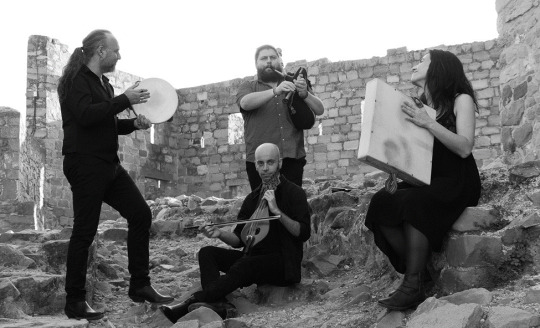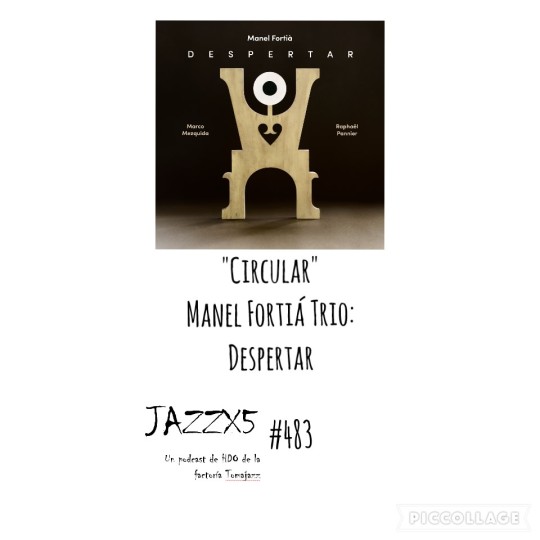#Segell Microscopi
Text
Cabra — Vol. 1 (Segell Microscopi)

Cabra is a group from Spain that offers a modern take on the musical traditions of that country. The members — Efrén López, Isabel Martín, Carlos Ramírez, and Juan Francisco Ballestero — play an incredibly wide range of instruments, including hurdy gurdy and various lutes, bagpipes, fiddles and hand percussion, as a video produced for the project shows. The lyrics are original, by Martín, but seem to deal with subjects appropriate to the music, typically, love and longing. This version of Spanish roots music is, quite simply, lovely, beautifully played and full of mystery.
The sound, given the instrumentation, is reminiscent of medieval and Renaissance music, and Martín’s pure voice, sometimes multi-tracked, has some similarities to the voices of Sandy Denny and Annie Haslam. Often, her singing combines with string and woodwind drones that float over rattling percussion. On slower songs, such as “Bolero” and “Fandango Lidio,” alternating instrumental and vocal sections create mounting tension that resolves in satisfying ways.
Each track is carefully arranged and distinctive. The epic-length opener “Narisco + No Te Cases” starts things off with a soaring vocal over rippling plucked strings, develops steadily, and comes together at the end like a well-told tale. On “En Lo Mas Alto del Cielo,” gentle flute and strings hold forth for more than two minutes, at which point Martín introduces a complex vocal line that becomes submerged in percussion, and the track resolves in a flurry of winds and strings. The instrumental “Corrido” is a three-minute thrill ride with something of an Ennio Morricone feel. Examples of the attention to detail throughout the recording include what sounds like a jaw harp near the end of “La Avellana,” what sounds like a backwards-tracked instrument at the beginning of “En Lo Mas Alto del Cielo,” the sounds of chickens accompanying Martín at the beginning of “El Toro de Mieza,” and a percussion breakdown in the middle of “Gorrontxategitarren Pandangoa” that makes clear this is not easy listening music.
My knowledge of the genre is too limited for me to say how distinctive Cabra’s music is within the modern folk scene in Spain or its relationship to the deep tradition of Spanish music. In any case, the potential appeal of Vol. 1 seems quite wide, including listeners with a taste for traditional, folk, and medieval/Renaissance music and those eager to hear unusual sounds, and they are likely to find themselves looking forward to Vol. 2.
Jim Marks
#cabra#vol. 1#segell microscopi#jim marks#albumreview#dusted magazine#folk music#renaissance music#medieval music#spain
3 notes
·
View notes
Text
CAROLA ORTIZ presenta 'E VIRA E VIRA', tercer avance de su nuevo disco 'Cantareras'. (Segell Microscopi)
CAROLA ORTIZ presenta ‘E VIRA E VIRA’, tercer avance de su nuevo disco ‘Cantareras’. (Segell Microscopi)
“E Vira y Vira” es un maneo tradicional de la zona de la Costa da Morte (Galicia). Carola Ortiz lo encontró grabado en el archivo de folclore gallego por una mujer que emigró a Montevideo y cuya grabación se hizo desde allí.
Continue reading Untitled

View On WordPress
0 notes
Text
Mirage Station playlist for November 16th, 2022
1. Sofia Faizrakhmanova “Kalina (Snowball Tree) 2 | Калина 2” from Erzyan Morot: Fiddle Tunes from Erzya Mordva Villages of Samara Province (Antonovka 2022)
2. Alexis Zoumbas “Kleftes (Tsamikos) (Bandit's Dance)” from A Lament For Epirus 1926-1928 (Angry Mom Archives 2014)
3. Jrpjej “Къоджэ Бэрдыкъо Мыхьамэты игъыбз” from After The War Comes Funeral: Circassian Songs of Resistance and Sorrow 1763-1864 (Ored Recordings 2022)
4. Stephan Micus “First Snow” Desert Poems (ECM 2001)
5. Nicolas Horvath “Quiet Rhythms No. 1 - Prologue - Action” Susman Quiet Rhythms Book I (Self-released 2022)
6. Emahoy Tsege Mariam Gebru “Song Of The Sea” from Emahoy Tsege Mariam Gebru (Mississippi 2022)
7. Marewrew “オロウル ロアウン (orouru roaun)” from きらきら星 / ミケミケノチウ (mikemike nociw) (Chikar Studio 2019)
8. Yakob Mberu, Yermiasu August Pah “Batu Matia” from Music Of Sasandu (King 1994)
9. Ebanga Theophile “Mfohlo Moan / Lullaby “ from Mvet Ai Mendzang: Music Of The Beti In Cameroon (Wergo 2005)
10. Eduardo Mateo “El Son Oro Scope” from Cuerpo y Alma (Sondor 1984)
11. Momi Maiga “Mansani” from Nio (Segell Microscopi 2022)

0 notes
Text
"Circular" [Manel Fortià Trio. Single adelanto de Despertar (Segell Microscopi, 2022)] Por Pachi Tapiz. JazzX5 #483 [Minipodcast de jazz]
“Circular” [Manel Fortià Trio. Single adelanto de Despertar (Segell Microscopi, 2022)] Por Pachi Tapiz. JazzX5 #483 [Minipodcast de jazz]
“Circular (to JFK AirTrain)”
Manel Fortià Trio: Despertar (Segell Microscopi, 2022)
Manel Fortià, Marco Mezquida, Raphael Panniër. El tema es una composición de Manel Fortià.
Despertar, el estreno del Manel Fortià Trio, se publicará el 12 de mayo de 2022 por Segell Microscopi. El 19 de abril se publica como adelanto el sencillo “Circular”, el segundo de los nueve temas de esta grabación.
El…

View On WordPress
#JazzX5#Manel Fortià#Manel Fortià Trio#Marco Mezquida#Minipodcast#Pachi Tapiz#podcast de jazz#Raphaël Pannier#Segell Microscopic
0 notes
Text
La Montaña Rusa 22.2020. Arild Andersen. Dani López Quartet. Ghost Rhythms. Yao/Smith/Hughes Sextet.
Abrimos este número 22.2020 de La Montaña Rusa con Shimri, publicado en 1977 por el contrabajista Arild Andersen, para ECM y que ha sido nuestro Clásico de la Semana.
En nuestra sección Jazz en Español, visitamos una vez más el sorprendente catálogo de Segell Microscopi para escuchar el nuevo trabajo del Dani López Quartet, El que fan les coses quan no les mires, publicado este 2020.
Nuestr…
View On WordPress
0 notes
Text
Èlia Lucas Quartet — Introspecció (Segell Microscopi)

Photo by Anton Tendero
youtube
Pianist Èlia Lucas’s compositions combine elements of jazz, classical and pop in inventive ways, and her group performs them with passion and conviction on Introspecció. The polished arrangements reflect considerable time woodshedding and performing as a quartet, and upright bassist Tomàs Pujol and drummer Kike Pérez also play together in Trio Nilo, sometimes joined by sax player Edu Pons, while Pons and sometimes Lucas play in Pérez’s quintet. There are undoubtedly further connections, and these musicians’ familiarity and comfort with each other are evident here. As so often in jazz (and other kinds of music), a tight-knit scene makes for tight and generous interplay.
On the more obviously classically influenced tracks, such as “Intro” and “Bach inspirations,” which begins with a telepathic sax and piano duo and then transitions from the baroque to jazz, the members of the group well demonstrate their chops and establish the mood. These and the other tracks are generally mid-tempo and unfold gradually. “Cercles” is built around a pair of solos by Pons with some inspired soloing from Lucas and Pujol in between. And “Natural” wraps things up elegantly with Pons starting out alone on soprano and gorgeous soloing from Lucas and arco from Pujol.
The quartet is also capable of generating some fire. From a gentle start, “Dreamin’” (which deserves a better title) builds up a ferocious head of steam thanks to some great skronk from Pons and powerful tom and cymbal work by Perez punctuated by a too-brief solo from Pujol. Even “Bach inspirations” generates considerable force in its final minute. “Línies” features another quick solo from Pujol and a nice shift around the mid-point when Pons at last joins the other three to deliver a solo that, unfortunately, is swallowed up in a fade-out at the end.
The blend of chamber jazz with freer elements is consistently effective across Introspecció. The sound benefits from the clarity of the recording as well as the sympathetic ensemble playing. Lucas’s compositions are accessible and memorable, and the band plays them with the familiarity of standards. This record is also further evidence of the vitality of jazz in the Iberian Peninsula.
Jim Marks
#Èlia Lucas Quartet#Introspecció#Segell Microscopi#jim marks#albumreview#dusted magazine#jazz#classical music#spain
6 notes
·
View notes